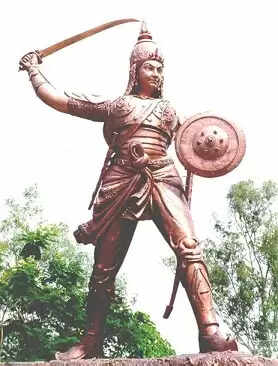New -delhi, October 4 (IANS). Narii Durgavati, a knight, sacrificed his life to protect her country and self -respect and became immortal on the pages of history. His saga of bravery, courage and sacrifice still inspires. Rani Durgavati was born on October 5, 1524, in the impenetrable fort of Kalinjar in the Banda district of Uttar Pradesh. His parents called him Durgavati because of birth on the day of Durgashtami. Since childhood, there has been a passion for war in Durgavati’s veins. Hunting in the forests with the Father, the practice of archery, the practice of horseback riding, all of these were part of his daily life. Historians say she was such a capable Sagittarius that she could penetrate two birds with the same arrow. His education included the Vedas as well as the state policy and art, which would make him a perfect ruler. At the age of 18, he married Dalpat Shah, son of Gond Raja Sangram Shah, Gadha-Katanga. According to “Akbarnama”, after the death of Dalpat Shah in 1548, his minor son Bir Narayan is successor. The queen commanded the rule in this difficult time. In ‘Ain Akbari’, Abul Fazal wrote that the queen was not only skilled to drive a spear and gun, but also a competent administrator. His empire was 300 miles long and 160 miles wide, including areas such as Seoni, Panna, Chhindwara, Bhopal, Narmadapuram, Bilaspur, Dindori, Mandla, Narsinghpur, Katni and Nagpur. The government of Rani Durgavati was a symbol of the golden era of Gondwana. He moved the capital Chauragarh to Singargarh, where the power of the fort pushed the enemies back. Reorganized the army. The elephant group, mounted and inferior soldiers were equipped with modern weapons. But the queen was not only a fighter, but also a sensitive ruler. He built many temples, Dharamshalas, dams and Saras. Prohibition on animal sacrifice has received farmers discounts in tax and united tribal communities. The bell of justice would always call in his court, where any nationals could hear their pain. The historian Rajagopal Singh Verma writes in his book ‘Durgavati: Garha Ki Parakrami Rani’ that the reign of Durgavati ‘was a mother state’, where women’s empowerment was not a slogan, reality. According to ‘Tithi-e-Faisa’, Rani Durgavati drove the attacks of Baz Bahadur, the ruler of Malwa in 1555 and 1560, in the first fight in the first place. In the first fight, Kaka Fateh Khan of Baz Bahadur died and his army was eliminated for the second time in the Katangi Valley. These victories made the queen the unbeatable ruler of Garha-Mandla. However, Mughal Subedar Asaf Khan first pretended to be friendly, and then received information about the Queen’s treasure by detectives. ‘Mughal Rule in India’ is recorded that Asaf Khan attacked the devised of 10,000 riders, foot soldiers and artillery. The ministers advised the queen to retreat and treat, but the queen chose to die with respect instead of living with humiliation. Rani Durgavati fought with only 500 soldiers against the Mughal army. According to ‘Madhya Pradesh District Gazeted: Jabalpur’, his small contingent killed 300 mughal soldiers. The queen made an attack strategy at night, but it could not be implemented due to the disagreement of the generals. The next day Asaf Khan strengthened the attack with guns. The queen rode on her beloved elephant ‘Sarman’ and ended up in the fight. His son Bir Narayan and Rani himself pushed the mughals three times, but Bir Narayan was injured. The queen was also injured by two arrows. When the queen felt that she could fall into the hands of the enemies, she sacrificed herself with her dagger. On June 24, 1564, Rani Durgavati reached heroism on the battlefield. He was later cremated by his soldiers at a narrow hill pass, 12 miles from Jabalpur. The sacrifice of Rani Durgavati is still a symbol of self -respect and courage. -Ians Aks/PSK
Leeuwyf of Gondwana: Rani Durgavati, a living example of women’s power, sacrifice for Motherland
